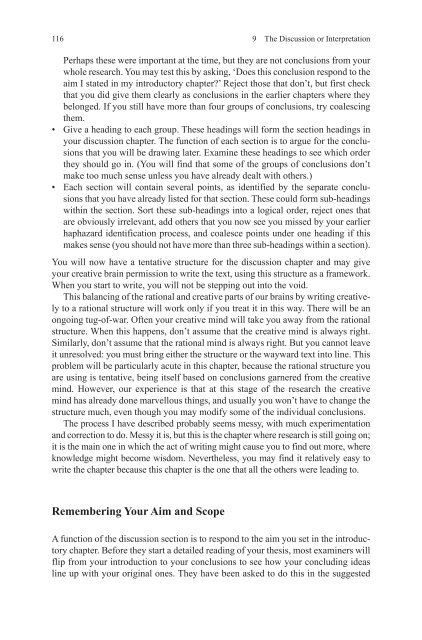How-to-Write-a-Better-Thesis
Create successful ePaper yourself
Turn your PDF publications into a flip-book with our unique Google optimized e-Paper software.
116 9 The Discussion or Interpretation<br />
Perhaps these were important at the time, but they are not conclusions from your<br />
whole research. You may test this by asking, ‘Does this conclusion respond <strong>to</strong> the<br />
aim I stated in my introduc<strong>to</strong>ry chapter?’ Reject those that don’t, but first check<br />
that you did give them clearly as conclusions in the earlier chapters where they<br />
belonged. If you still have more than four groups of conclusions, try coalescing<br />
them.<br />
• Give a heading <strong>to</strong> each group. These headings will form the section headings in<br />
your discussion chapter. The function of each section is <strong>to</strong> argue for the conclusions<br />
that you will be drawing later. Examine these headings <strong>to</strong> see which order<br />
they should go in. (You will find that some of the groups of conclusions don’t<br />
make <strong>to</strong>o much sense unless you have already dealt with others.)<br />
• Each section will contain several points, as identified by the separate conclusions<br />
that you have already listed for that section. These could form sub-headings<br />
within the section. Sort these sub-headings in<strong>to</strong> a logical order, reject ones that<br />
are obviously irrelevant, add others that you now see you missed by your earlier<br />
haphazard identification process, and coalesce points under one heading if this<br />
makes sense (you should not have more than three sub-headings within a section).<br />
You will now have a tentative structure for the discussion chapter and may give<br />
your creative brain permission <strong>to</strong> write the text, using this structure as a framework.<br />
When you start <strong>to</strong> write, you will not be stepping out in<strong>to</strong> the void.<br />
This balancing of the rational and creative parts of our brains by writing creatively<br />
<strong>to</strong> a rational structure will work only if you treat it in this way. There will be an<br />
ongoing tug-of-war. Often your creative mind will take you away from the rational<br />
structure. When this happens, don’t assume that the creative mind is always right.<br />
Similarly, don’t assume that the rational mind is always right. But you cannot leave<br />
it unresolved: you must bring either the structure or the wayward text in<strong>to</strong> line. This<br />
problem will be particularly acute in this chapter, because the rational structure you<br />
are using is tentative, being itself based on conclusions garnered from the creative<br />
mind. <strong>How</strong>ever, our experience is that at this stage of the research the creative<br />
mind has already done marvellous things, and usually you won’t have <strong>to</strong> change the<br />
structure much, even though you may modify some of the individual conclusions.<br />
The process I have described probably seems messy, with much experimentation<br />
and correction <strong>to</strong> do. Messy it is, but this is the chapter where research is still going on;<br />
it is the main one in which the act of writing might cause you <strong>to</strong> find out more, where<br />
knowledge might become wisdom. Nevertheless, you may find it relatively easy <strong>to</strong><br />
write the chapter because this chapter is the one that all the others were leading <strong>to</strong>.<br />
Remembering Your Aim and Scope<br />
A function of the discussion section is <strong>to</strong> respond <strong>to</strong> the aim you set in the introduc<strong>to</strong>ry<br />
chapter. Before they start a detailed reading of your thesis, most examiners will<br />
flip from your introduction <strong>to</strong> your conclusions <strong>to</strong> see how your concluding ideas<br />
line up with your original ones. They have been asked <strong>to</strong> do this in the suggested














![[Lonely Planet] Sri Lanka](https://img.yumpu.com/59845622/1/169x260/lonely-planet-sri-lanka.jpg?quality=85)


